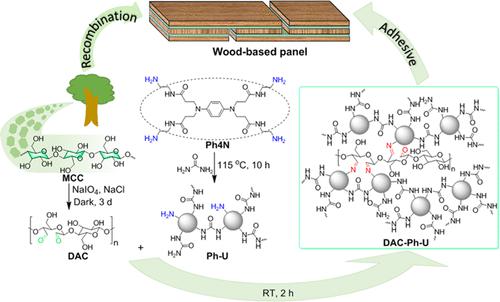当前位置:
X-MOL 学术
›
ACS Sustain. Chem. Eng.
›
论文详情
Our official English website, www.x-mol.net, welcomes your
feedback! (Note: you will need to create a separate account there.)
Integration of Aromatic Polyurea and Dialdehyde Cellulose as High-Performance Hybrid Resin Adhesives for Bonding Wood
ACS Sustainable Chemistry & Engineering ( IF 7.1 ) Pub Date : 2023-08-03 , DOI: 10.1021/acssuschemeng.3c01673 Zhi Li 1 , Min Gu 1 , Guanben Du 1, 2 , Jiayu Wang 1 , Tongda Liu 1 , Kelu Ni 1 , Hongxing Yang 1 , Xiaoping Tan 1 , Xin Ran 1 , Wei Gao 1 , Long Yang 1, 2
ACS Sustainable Chemistry & Engineering ( IF 7.1 ) Pub Date : 2023-08-03 , DOI: 10.1021/acssuschemeng.3c01673 Zhi Li 1 , Min Gu 1 , Guanben Du 1, 2 , Jiayu Wang 1 , Tongda Liu 1 , Kelu Ni 1 , Hongxing Yang 1 , Xiaoping Tan 1 , Xin Ran 1 , Wei Gao 1 , Long Yang 1, 2
Affiliation

|
The development of wood adhesives that exhibit robust adhesion, exceptional water resistance, sustainability, affordability, nontoxicity, and simplicity is highly recommended for practical applications. In this study, the structure of microcrystalline cellulose was successfully modified with dialdehyde groups based on previous reports. Aromatic polyamines and urea were polymerized into phenyl-polyurea (Ph-U) through fusion and condensation, without the use of catalysts or solvents. The DAC-Ph-U adhesives were synthesized through the reaction between dialdehyde cellulose (DAC) and Ph-U under ambient conditions. Reinforcing and cross-linking effects of Ph-U on its properties were systematically investigated. The mechanical, adhesive, and water repellent properties were enhanced through the introduction of aldehyde (from DAC) and amino group (from Ph-U) interactions into the cross-linking structure with Schiff base cross-linking. The interaction of covalent (C=N) and multiple non-covalent bonds in the cross-linked system functions as a hydrophobic barrier, impeding water infiltration into the bonding interface. The bonding strength test revealed that the optimal strength of DAC-Ph-U adhesives reached 2.91 MPa (dry strength), 1.96 MPa (after 63 °C water immersion), and 1.75 MPa (after burning water immersion), respectively. Its comprehensive properties were not only superior to traditional formaldehyde-based resin adhesives but also far higher than the requirements of industrial wood-based panels. This study provides ideas for replacing fossil aldehydes such as formaldehyde, glyoxal, glutaraldehyde, etc. in wood adhesive fields and can be potentially generalized to reinforce the performance of biocomposites, coatings, plastics, hydrogels, etc.
更新日期:2023-08-03


















































 京公网安备 11010802027423号
京公网安备 11010802027423号